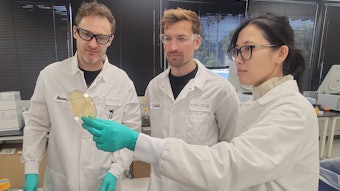
Transdermal patches enable the controlled release of compounds such as topical actives and nutrients through the skin into the body. Silicone adhesive gels designed for such are tested here for their potential in cosmetics and topical pharma applications.
Modern dressings and patches are truly high-tech products. These thin, flexible bandages can do more than cover and protect wounds, and support the healing process. They offer entirely new areas for application thanks to functional layers that can store and release various types of active ingredients for medical, personal care or cosmetic applications – from anti-aging products, hormone therapy and pain management, to medications for treating high blood pressure and Alzheimer’s.
Adhesives for transdermal drug delivery systems (TDDS) can release an active ingredient stored in the adhesive matrix in a way that it can be absorbed by the patient’s skin. This process is diffusion controlled, which leads to a defined rate and volume of active substance release.
More recently, the focus has been to improve the comfort of patches for patients, especially for longer-term wear. For example, using silicone gels as skin adhesives reduces irritation since they are biocompatible. Recent advancements also aim to improve the consistent release of actives.
The demand for silicone adhesives in coating wound dressings and scar patches continues to grow.1-3 This likely due in part to their excellent adhesive properties as well as gentle removal from skin. Thus, borrowing a page from the medical field, the authors explored the application of silicone adhesive gels in transdermal patches for the controlled release of non-prescription and cosmetic actives.
Evaluations described here measured the release of melatonin, caffeine, green tea, vitamins B3 and E, and retinol using the Franz cell method and test substrates. Before delving in, however, the authors describe the types of transdermal patch technologies currently available, the benefits afforded by silicones, and the growing demand for topical delivery of compounds.
Current Patch Technologies
Currently, two patch technologies (see Figure 1, below) dominate the market: reservoir patch designs and drug-in-adhesive patches.
Reservoir patches: The reservoir patch design includes a liquid compartment containing a drug solution or suspension sandwiched between an impermeable backing layer and a rate-controlling membrane. The adhesive layer is applied between the rate-controlling membrane and a release liner, which is peeled off before use.
Drug-in-adhesive patches: Drug-in-adhesive patches are different in structure and function. Here, the adhesive matrix itself contains the delivery system with the active ingredient. In addition to polymers such as polyacrylates or polyurethanes, silicones are used in delivery systems, which as will be shown, provide significant advantages.
Drug-in-adhesive platforms are generally preferred by both manufacturers and customers due to the ease of coating and converting processes, and simplicity of the patch designs.4 Therefore, drug-in-adhesive patches were the focus of the present article.
Advantages of Silicone Adhesives for Patches
Silicone adhesives demonstrate excellent skin compatibility and have long been considered an important material in wound care. They are non-allergenic, breathable, odorless and can be removed from the skin without causing pain.
Silicone adhesive layers offer another advantage: they can be repositioned. If a patch is applied incorrectly, it can easily be peeled off and positioned again – and after repositioning, silicone-coated products adhere to the skin just as well. This can be especially beneficial in cases of patches used for infants and elderly patients.11 These properties have made silicone adhesives an attractive material for TDDS applications.
Benefits of Transdermal Delivery
Administering a pharmaceutical or nutraceutical via transdermal patches or topical delivery presents several advantages. For example, the steady release of the ingredient ensures that a constant level is maintained in the bloodstream. Another advantage is that it enters the bloodstream directly,5 which helps to eliminate common gastrointestinal side effects of oral medication.6 In addition, patches do not need to be replaced frequently, which in turn improves patient compliance.
Demand for Transdermal Drug Delivery Systems
Considering their benefits, TDDS are experiencing global demand. According to market analysts,7 such patches will soon dominate the TDDS market – which is forecasted to expand at a CAGR of 3.9% until 2032 to reach a market volume of US $11.2 billion. Several estimates also see North America as the largest market for these types of patches. Silicone adhesives will have a growing share in this market. In addition, according to forecasts, transdermal patches will be used chiefly in delivery applications in the pharmaceutical and nutraceutical fields.8
Exploring TDDS Patches for New Markets
Transdermal patches are also increasingly used for non-prescription and cosmetic applications. Future market trends for transdermal patches depend on several factors: the materials used, their formulation and the optimum integration and release of active ingredients.
The authors’ company has been exploring these factors to develop silicone adhesive formulas for various applications – from antimicrobial wound care systems and low-trauma patches, to solutions for wearables. The main focus has been on silicone gels to administer therapeutic drugs, over-the-counter (OTC) active ingredients, and ingredients such as dietary supplements and herbal remedies.
Initially, processes were explored for integrating substances such as dexamethasone, ibuprofen, melatonin, vitamin E, retinol and curcumin into the silicone gel matrix. Studies also were carried out to assess the rate at which the incorporated compounds are released and absorbed by the skin.
Based on these results, the release of compounds was optimized using customized silicone adhesive formulations and drug release profiles. In addition, adhesive properties (i.e., tack and peel) and the skin compatibility of these types of patch delivery systems were enhanced.
Embedding Ingredients in Silicone Adhesive Gels
To develop silicone-based patches, a process was required to ensure that the integration of the active compounds in the silicone gel was as homogeneous as possible. Since silicones are hydrophobic, fat-soluble actives are best-suited for this application. Critically, active ingredients must be embedded without phase separation or curing problems, and with good dispersion and stability properties.
In addition, finding the right balance between the individual components of the silicone gel adhesive formula is key. When incorporating active pharmaceutical ingredients (APIs) and excipients, formulators must exercise meticulous control to achieve the desired release profiles without compromising the physicochemical properties of the polymer matrix. Critical characteristics such as adhesion to the skin, cohesive strength, peel, shear resistance and tackiness must also be measured and preserved. Furthermore, while optimizing the adhesive's wear performance, it is imperative to maintain its atraumatic removal properties to minimize skin irritation and damage.
All of these properties can be assessed through physical test methods to ensure the silicone adhesive system delivers therapeutic efficacy while also maintaining its structural integrity.9 Only once these checks and balances are in place can compounds be optimally embedded in the adhesive matrix and be released steadily and uniformly through the skin.
A Note on Room-temperature Vulcanizing Silicones
The company’s silicone gel adhesivesa described herein are categorized as addition-curing, room-temperature vulcanizing silicones (RTV silicones). This means they cure from liquid form to a flexible silicone rubber at room temperature. The materials consist of two components (and are thus referred to as RTV-2): the silicone rubber base and the crosslinker.
Silicone gels form particularly soft vulcanizates. They are characterized by precise and efficient curing at room temperature, a fast curing time, a high degree of purity and excellent mechanical strength in the finished product. Note, however, that the reactivity of the platinum catalyst must be taken into account when selecting and integrating ingredients.
When working with silicone RTV-2 materials, it is also crucial to be aware of the potential presence of chemical contaminants. The following compounds should be checked regularly since they can slow – or in some cases prevent – the reactivity of silicones:
- Sulfur compounds such as sulfides,
- Nitrogen-containing compounds including amines, amides, nitriles and cyanates,
- Tin compounds such as tin salts,
- Phosphorus compounds including phosphine and phosphite, and
- Solvents like alcohols and esters, as well as certain unsaturated compounds.
Modifications to the silicone adhesive system and active ingredient may therefore be necessary. This could include crosslinker and ratio changes, or the use of chemical agents to isolate the interaction between actives or excipients and the platinum catalyst.
Analyzing the Diffusion of Active Ingredients
The major barrier actives encounter for transdermal delivery is the uppermost layer of human skin: the stratum corneum. Once passing through this layer, however, ingredients reach the subcutaneous tissue and can enter the bloodstream.
For the described benchmark studies, the release and permeation kinetics of ~20 different ingredients embedded in a 300 µm-thick (maximum) silicone adhesive gel matrix were analyzed. The Franz cell method (see Figure 2, below) was used to investigate the skin penetration, release and absorption of active ingredients from different formulas.
As many readers know, the Franz cell method has proven reliable in pharmacology and cosmetic tests. It is commonly used to simulate the behavior of active compounds and formulations when applied to the skin. In this system, the test sample is placed in contact with a membraneb and the rate of transfer is determined by collecting the permeate on the opposite side of the membrane. This release and permeation can be determined over time and measured by high-performance liquid chromatography (HPLC).
For the present work, results for the controlled release of melatonin, caffeine and green tea from the company’s silicone adhesive-based test patchesc are shown in Figure 3, below. These demonstrate that the silicone adhesive gels are generally suitable for transdermal systems – although their suitability depends on the individual compounds and required dosage.
Fine Tuning Active Ingredient Release
Considering these dependencies, additional work focused on improving the release properties of silicone adhesive-based gel patch formulas as well as their compatibility with non-steroidal anti-inflammatory drugs, OTC actives and non-pharmaceutical ingredients such as caffeine, vitamin E, niacinamide (vitamin B3), curcumin, melatonin, retinol (vitamin A), dexamethasone and ibuprofen. The active compounds were classified based on their miscibility in water, fat or other media. The release rates can be quantified using either the Franz cell method or the orbital shaker method; the latter was employed here.
Similar to the Franz cell method, in the orbital shaker method, silicone adhesive gels containing active compounds were exposed to aqueous solutions such as water or phosphate buffer solutions under consistent and uniform mixing conditions in vials. Samples were then collected over time and were analytically characterized using appropriate techniques such as HPLC and inductively coupled plasma (ICP). Each test was conducted in duplicate.
As the results in Figure 4 (see below) demonstrate, the company’s various optimized silicone adhesive gel formulas achieved significantly improved and variable types of release rates – i.e., adjustable, burst and steady – for vitamins B3 and E, and melatonin. With the help of Hansen solubility parameters, further optimizations were possible (not shown).
This improved delivery performance was also applied to the gold standard anti-aging active retinol (see Figure 5 below). Here, an optimized silicone adhesive gel patch demonstrated a significant release of retinol, reaching a peak concentration of approximately 14 µg/cm² after approximately one hour. In contrast, the commercial patch exhibited a minimal retinol release, with levels remaining below 0.1 µg/cm² throughout the observed time period.
Discussion – Optimizing Release Rates
The results of these comparative studies demonstrate the effective controlled release of various active ingredients from silicone adhesive gel matrices. In addition, the silicone adhesives could be optimized for different release rates; such as a burst-like release of actives immediately after application, or a well-controlled dose release over a longer period of time. Further improvements improved patch performance beyond that of commercially available benchmark products. Silicone adhesive gels are therefore a promising option for transdermal delivery – which is particularly attractive for the cosmetics industry, considering the numerous beauty patches being offered incorporating a wide variety of ingredients.10
Conclusion
The presented findings show that silicone adhesive gels are well-suited for application in transdermal patches. A wide range of actives for cosmetics and/or pharma applications were incorporated into them, and their administration was successfully controlled through a variety of release profiles. Patches coated with silicone adhesive gels could thus be customized for given actives at specified released rates for the treatment goals of the respective application.
Silicone gels also historically display good skin compatibility and even allow patches worn for long periods of time to be removed and replaced without damaging skin, as has been shown elsewhere.12 Silicone gel adhesives can thus set a new standards in topical delivery and skin safety for the development of new transdermal therapeutic systems.
footnotes
a Silpuran soft silicone adhesive gels are a product of Wacker.
b Strat-M membrane
c Silpuran 2130
References
1. Shin, H.J., Lee, B.K. and Kang, H.A. (2024). Transdermal properties of cell-penetrating peptides: Applications and skin penetration mechanisms. ACS Applied Bio Materials. Available at https://pubs.acs.org/toc/aabmcb/7/1
2. Lee, B.K., Ryu, J.H., … Yu, H.Y., et al. (2017). Silicone-based adhesives with highly tunable adhesion force for skin-contact applications. Advanced Healthcare Materials. Available at https://advanced.onlinelibrary.wiley.com/doi/10.1002/adhm.201700621
3. Liu, J. (Accessed 2025, Mar 9). Medical adhesives and skin adhesion. Pressure Sensitive Tape Council (PSTC). Available at https://pstc.org/wp-content/uploads/2022/05/Liu-Jacob2012.pdf
4. Bird, D. and Ravindra, N.M. (2020, Mar 7). Transdermal drug delivery and patches – An overview. Medical Devices and Sensors. Available at https://onlinelibrary.wiley.com/doi/10.1002/mds3.10069
5. Hearnden, V., Sankar, V., … Thornhill, M.H., et al. (2012, Jan). New developments and opportunities in oral mucosal drug delivery for local and systemic disease. Advanced Drug Delivery Reviews. Available at https://www.sciencedirect.com/science/article/abs/pii/S0169409X11000433
6. Jeong, W.Y., Kwon, M., Choi, H.E. and Kim, K.S. (2021, Jul 28). Recent advances in transdermal drug delivery systems: A review. Biomaterials Research. Available at https://link.springer.com/article/10.1186/s40824-021-00226-6
7. IMARC. (2024, Jul 1). Transdermal skin patches market report by type, distribution channel, application and region 2024-2032. GII Global Information, Inc. Available at https://www.giiresearch.com/report/imarc1519736-transdermal-skin-patches-market-report-by-type.html
8. Ibid Ref 6
9. Wongbakerfaces.org. (Accessed 2025, Mar 9). Welcome to the Wong-Baker FACES Foundation. The official home of the Wong-Baker FACES Pain Rating Scale. American Society for Testing and Materials (ASTM): ASTM D2979-16 (Tack), ASTM D3330 (Peel), ASTM D3654 (Shear). Available at https://wongbakerfaces.org/ (trauma scale).
10. Grammatikopoulou, M.G., Gkiouras, K., … Bogdanos, D.P., et al. (2021, Sep). Peeking into the future: Transdermal patches for the delivery of micronutrient supplements. Metabolism Open. Available at https://www.sciencedirect.com/science/article/pii/S2589936821000335
11. Dykes, P.J., Heggie, R. and Hill, S.A. (2001, Feb). Effects of adhesive dressing on the stratum corneum. J Wound Care. Available at https://pubmed.ncbi.nlm.nih.gov/12964220/
12. Wacker. (Accessed 2025, Mar 9). Silpuran silicone adhesives – Gentle protection that stays in place. Available at https://www.wacker.com/cms/en-us/products/insights/silicones-health-care-adhesives.html











